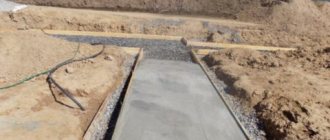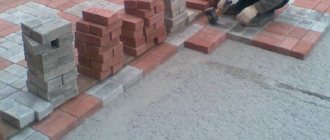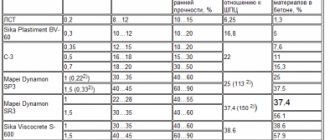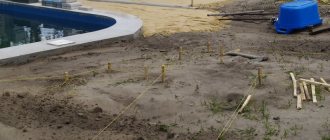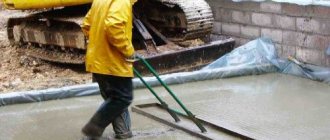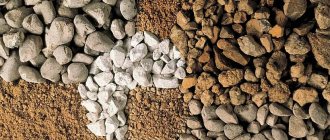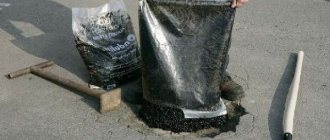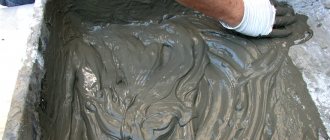Polypropylene fiber
Universal polypropylene reinforcing fiber for adding to the solution.
More details
Important!
When rearranging the vibrator, maintain a distance of no more than 1.5 radii of action. When processing a new layer, the deep vibrator is immersed 5–8 cm into the previous layer to ensure the solidity of the product.
Tamping with manual and pneumatic rammers is used when laying super-rigid concrete mixtures in lightly reinforced and unreinforced structures or when it is impossible to use vibration.
Casting
Laying concrete mixture by casting is used when using mobile mixtures P4–P5. As a rule, these are mixtures with plasticizers.
In this case, the mixture does not require processing; it spreads and compacts under the influence of gravity.
This method of laying and compacting the concrete mixture allows you to save cement, electricity, labor costs and obtain durable structures. It is also suitable for use in thin-walled or densely reinforced structures.
Pressure concrete placement
Pressure concreting is used, for example, in cases where it is necessary to lay the concrete mixture under water.
In this case, a fill of coarse aggregate is created in the formwork, then concrete solution is supplied under pressure through steel pipes installed at a certain distance from each other. When the thickness of the structure is less than 1 m, the solution is injected through the side injection holes.
The advantages of this method include:
- reducing labor costs for mixing concrete mixture;
- elimination of concreting seams, since the process is carried out continuously;
- simplified work technology.
One of the disadvantages is the need to use solutions with a high cement content.
Important!
The methods of casting and pressure laying are called special methods and are used in cases where laying and compaction by conventional methods (vibration, compaction) is impractical, ineffective or impossible.
Technology for laying concrete mixture
The division of a structural block into building blocks is carried out: by volume; by height; by area in plan.
By volume
. If the operating mode of a centralized concrete plant (CPB) is continuous, then the volume of the building block can be any. If the work mode is with a break (1-2 shifts), then there will be a break. In this case, the largest volume of a block depends on how much the pulp and paper plant will issue for a given building block per day of work, i.e. the maximum volume of a building block will be
m3, (2.83)
where Pcbz is the productivity of a centralized concrete plant,
m3/h;
t
nepr – duration of work of the pulp and paper plant, hours.
Number of building blocks by volume
(2.84)
where V
k – volume of the structural block, m3;
– maximum volume of the building block, m3.
By height
. The maximum height (due to the convenience of working with formwork and not loading the lower weak layers of concrete) is 5–6 m. At a height exceeding 5–6 m, the structure is divided into tiers.
The number of tiers is determined by the formula
, (2.85)
where H
k – height of the structural block, m;
– maximum height of the building block, m.
Based on the area of the block in plan.
The area of the building block is limited by the laying conditions of each subsequent layer before the mixture begins to set in the previously laid underlying layer. This achieves reliable monolithic sealing between the layers.
The maximum area (m2) of a building block can be determined by the formula
(2.86)
where Pch is the hourly intensity of laying the concrete mixture, m3/h;
t
сх – time from the moment of water supply when preparing concrete
mixture before it begins to set;
t
tr – time spent on delivering the concrete mixture from the plant to
places of installation, h;
t
uk – time spent on laying concrete, h;
kz – safety factor for random delays in the transport route
means and when laying concrete, 0.8;
h
sl – thickness of the laid layer.
If the building block has a large area, then the block is laid in two steps.
The concrete mixture is placed using three methods: compaction, casting and pressure placement. With each laying method, the basic rule must be observed - a new portion of the concrete mixture must be laid before the cement in the previously laid layer begins to set. This eliminates the need to construct working concreting joints along the height of the structure.
As a rule, installation in small structures (beams, columns, partitions, etc.) is carried out immediately to the entire height without interruption to eliminate the creation of working joints. In large structures, the concrete mixture is laid in horizontal layers, usually over the entire area at once.
If there are reinforcing bars in the form, the concrete mixture should envelop all the reinforcement and evenly, without gaps, fill all the free space between the walls of the form and the reinforcement, without forming cavities or cavities.
All layers are laid in the same direction of the same thickness, and concreting is carried out continuously. The duration of laying the layer is limited by the time when the cement begins to set. The next layer is laid only after the previous one has been properly compacted.
In vertical structures, the concrete mixture is laid in compliance with the following requirements: high columns are concreted in sections no more than 5 m high, and walls and partitions - no more than 3 m; columns with cross-sectional sides less than 0.4 m; walls or partitions less than 0.15 m thick , as well as columns of any cross-section with intersecting reinforcement clamps, are concreted without interruption on the side in sections with a height of no more than 2 ms, compacting the concrete mixture with internal or external vibrators.
Columns up to 5 m high and with a cross-section of at least 40×40 cm, in the absence of intersecting clamps, are concreted on top. At a height of more than 5 m, concreting begins in layers from the bottom of the column (from the open side of the formwork box) until the 5-meter height of the column remains. As layers of concrete mixture are laid, the formwork on the open side of the box is gradually increased; when 5 m remains to the top of the column, install the entire column box to the entire remaining height and continue concreting from above. In this case, before the start of lowering the concrete mixture, the surface of the joints of the laid concrete is cleaned and, through the installed box, covered with a 20 cm layer of cement mortar, which has the same strength as the concrete being laid.
The beams are concreted in layers along the entire length. The concrete in the beams is compacted using deep vibrators. In beams with a height of more than 50 cm, concrete is usually laid in two layers and vibrated in two stages. The beams are concreted together with the slab. To maintain the designed thickness of the slab, lighthouse slats are used, the upper plane of which coincides with the mark of the top of the slab. The concrete mixture placed in the floor slabs is compacted using surface vibrators.
Compacting the concrete mixture.
The concrete mixture placed in monolithic structures is compacted in order to ensure good filling of the formwork form with the concrete mixture and the best placement of the particles included in it. Well-compacted concrete has a higher density (density increases from 2.2 to 2.4–2.5 t/m3), strength, frost resistance, and water resistance.
The concrete mixture is compacted by baying, tamping, vibrating and vacuuming.
The main method of compacting concrete mixtures is vibration, or vibration compaction. The method is used to compact mixtures with a cone draft from 0 to 10 cm. The essence of this method of compacting a concrete mixture is to influence the mixture by vibration.
Depending on the type of structure, different types of vibrators are used. To compact horizontal structures (floor slabs, floors, roads), site vibrators (vibrating screeds) are used, which compact the concrete mixture from the surface. The vibrator can also be immersed in the concrete mixture by its working body (body). This compaction process is called internal vibration. This method gives high quality concrete compaction and is widely used. If it is impossible to use these vibrators, the method of external vibration of the structure is used, i.e. the vibrator is attached to the elements of the formwork and its vibration is transmitted in the form of vibrations of the concrete mixture.
When compacting the concrete mixture with internal vibrators (Fig. 2.18), the thickness of the laid layers is taken to be no more than 1.25 of their working part. When immersing the vibrator in the concrete mixture (for better adhesion between the individual layers), it should be deepened into the previously laid layer by 5–10 cm.
Rice. 2.18. Vibration compaction of concrete
mixtures: 1
– working body of the vibrator;
2
– previously laid layer of concrete;
3
– layer to be laid;
4
– formwork
Vibration duration
at one point depends on the type of vibrator and the technological characteristics of the concrete mixture, in particular, its mobility. The less mobility of the mixture being compacted, the longer the duration of its vibration compaction.
It should be remembered that if the vibration duration is insufficient, the mixture will be under-compacted, and the concrete will be porous and of poor quality. Excessively prolonged vibration leads to stratification of the mixture and deterioration of the quality of concrete. In each case, the optimal vibration time is determined experimentally. Approximately for internal vibrators it is 20–50 s.
The degree of vibration compaction is determined visually. The main signs of sufficient vibration compaction are: the cessation of settling of the concrete mixture, the appearance of laitance on its surface and the cessation of the release of air bubbles.
After vibratory compaction of the mixture at one position is completed, in order to avoid the appearance of voids, the vibrator is slowly pulled out without turning it off and moved to a new position. The distance between positions should not exceed one and a half radii of action of the vibrator, and the vibration zones should overlap each other. The range of action depends on the mobility of the concrete mixture and the type of vibrators. For a vibrator with a flexible shaft I-116A it ranges from 25 to 50 cm, for a vibrator I-50A - from 45 to 50 cm.
To obtain high-quality concrete, it is especially necessary to vibrate the mixture in the corners of the formwork and near their walls, in places with densely located reinforcement, and at the bends of the structure. In order not to disrupt the adhesion of concrete to reinforcement or embedded parts, when compacting the concrete mixture, it is not allowed to rest vibrators on reinforcement and embedded products, ties and other formwork fastening elements.
Using surface vibrators, the concrete mixture is compacted in separate strips with an overlap of the vibrated strip by at least 100 mm. The thickness of the layers processed by surface vibrators is 25–30 cm; Duration of work in one position – from 20 to 60 s. The end of vibration is determined by the external signs listed above.
⇐ Previous18Next ⇒
Recommended pages:
Rules for laying concrete mixture
Technological techniques used for concreting depend on the type of structure, design features of the formwork, climatic conditions, and composition of the concrete mixture:
- Concrete is placed into massive structures by unloading directly into the formwork, feeding it with a concrete pump or in buckets using cranes. Mixtures with a cone draft of 1–3 cm are used for lightly reinforced structures and mixtures with a cone draft of 4–6 cm are used for densely reinforced structures. The thickness of the laid layers of concrete mixture should be 30–40 cm.
- Small structures (such as partitions, beams, columns) are concreted immediately to their entire height without interruption in order to eliminate the construction of working joints. In large structures, the mixture is laid in horizontal layers, usually over the entire area at once. Each of these layers is compacted.
- Regardless of the chosen concreting method, a new portion of concrete is placed before the previous one begins to set, so that there is no need to create seams in the structure. On large structures, if this condition cannot be met, the mixture is poured in “steps” at least 3 m long.
- The floors are concreted and compacted with a vibratory screed, then treated with trowels. For the underlying layers, mixtures with a cone settlement of 0 to 2 cm are used. The underlying layers are concreted with “cards”-strips 3–4 m wide one at a time.
- The mixture is placed in the slabs in one layer.
- When constructing walls, the thickness of each section should not exceed 3 m. For walls more than 50 cm thick, subject to sparse reinforcement, mixtures with a cone draft of 4–6 cm are used. For thin and densely reinforced walls and partitions, mixtures with a cone draft of 6–10 cm are used.
Working seams
When laying concrete in layers, they strive to prevent the previous layer from setting in order to ensure the solidity of the structure. However, if you need to take a break from work, a working seam is arranged.
It is obtained if more than 7 hours have passed since the previous layer of concrete was laid, and it is able to withstand a dynamic impact of at least 1.5 MPa without destruction.
In this place the structure is weakened, so the working seam can only be made in the places specified by the technical documentation.
The plane of the working seam is arranged perpendicular to the axis of the element, and for walls and slabs - perpendicular to their surface.
To ensure that the layers are securely bonded to each other, the previous layer is processed:
- use wire brushes to clean the edge until the coarse aggregate is exposed;
- clean reinforcement bars;
- blown and washed with water;
- Before concreting, the cleaned surface is covered with a cement mortar with a composition corresponding to the composition of the concrete mixture used.
Methods for laying concrete mixture in formwork
The quality of concrete in a structure largely depends on the correct placement of the concrete mixture during concreting. The mixture must adhere tightly to the formwork, reinforcement and embedded parts of the structure and completely (without any voids) fill the volume of the concreted part of the structure.
Typically, the laying process is divided into two operations: leveling the concrete mixture supplied to the structure and compacting it at the laying site.
The most common concreting scheme involves laying horizontal layers over the entire area of the concreted part of the structure.
| Concreting with horizontal layers (a) and steps (b) |
| 1 - laid concrete, 2 - new layer of concrete mixture; N - no more than 1.5 m |
All layers are laid in the same direction and of the same thickness. The layer is concreted continuously.
The complexity of the leveling operation depends on the method of supplying the concrete mixture to the block, its mobility or rigidity and the thickness of the layers being laid.
If the concrete mixture can be supplied to any area of the structure being concreted, then the labor intensity of the leveling operation is reduced to a minimum; if not, then the concrete mixture has to be moved horizontally. When laying the mixture, throwing it over to avoid delamination is allowed only in exceptional cases; double transfer is not allowed at all.
The shape of the cone formed after unloading it from vehicles depends on the mobility and rigidity of the concrete mixture. A rigid concrete mixture forms a cone with steep slopes, while a flexible concrete mixture forms a cone with gentle slopes. The concrete mixture, which forms a cone with a gentle slope, is easier to distribute in the layer. The greater the thickness of the laid layers of concrete mixture, the less the amount of leveling work. The mixtures in the block are leveled using a small-sized bulldozer or manually with shovels.
Each laid layer is thoroughly compacted before laying the next one. The less fluid the mixture is, the more labor is required to compact it.
The duration of laying the layer is limited by the time when the cement begins to set. Overlapping the previous layer with the next one must be done before the cement in the previous layer begins to set. The time for laying and overlapping layers is determined by the laboratory. It depends on the outside temperature, weather conditions and the properties of the cement used, approximately it is equal to 2 hours.
If the laying time of the layer exceeded the period established by the laboratory, then when vibrating the subsequent layer, the solidity of the concrete of the previous one will be disrupted, so concreting should be stopped.
Resumption of concreting is allowed only when the concrete reaches a compressive strength of at least 15 kg/cm2. The moment when concrete reaches such strength is determined by the laboratory.
At the point of contact between previously laid concrete and freshly laid concrete, a so-called working joint is formed. To ensure good adhesion of previously laid concrete to freshly laid concrete, the surface of previously laid concrete is left uneven (not smoothed) and processed according to the rules set out in the section Installing formwork.
Immediately before concreting, the surfaces of hardened concrete are covered with a 2-5 cm thick cement mortar or a layer of plastic concrete mixture. The strength of the hardened mortar or concrete in the contact layers must be no lower than the strength of the concrete structures. In especially critical cases, colloidal cement adhesive with a water-cement ratio of up to 0.35 is used, applied with a thickness of no more than 5 mm to hardened concrete in the working seam before continuing concreting.
In large areas, it is sometimes impossible to cover the previous layer of concrete before the cement begins to set. In this regard, on some construction sites the concrete mixture is laid in steps (Fig. 98, b) with the simultaneous laying of 2-3 layers. When concreting in steps, there is no need to cover the layers over the entire area of the massif. In this case, a rigid concrete mixture is used and only the steps are covered.
Laying in steps is permitted provided that the detailed concreting technology is followed. This method is used when concreting hydraulic structures with long blocks with a length-to-width ratio of more than 2. In domestic construction, there are examples of concreting with blocks 70 m long and 15 m wide.
When concreting structures, it is necessary to ensure that the position of the formwork, reinforcement and embedded parts remains unchanged. While the concrete mixture has not hardened, some displacements from the design position can be easily eliminated.
During concreting, it is necessary to systematically clean the reinforcement, formwork and embedded parts from adhering mortar, and also protect the concrete structure from rain. Concrete washed away by rain must be removed from the structure.
It is advisable to erect monolithic concrete and reinforced concrete structures without seams. But during the construction of large structures, it is completely impossible to fulfill this requirement, since cracks would form in monolithic structures under the influence of temperature fluctuations and uneven settlement. Therefore, large concrete and reinforced concrete structures are divided into sections using expansion joints.
Seams that divide a structure into sections to prevent the appearance of cracks in concrete from thermal stress are called temperature joints. Seams that prevent cracks from appearing in concrete due to uneven settlement of the structure are called sedimentary. If the structure must have both temperature and sedimentation joints, they are usually combined. Such expansion joints are called temperature-sedimentary joints.
Expansion joints are filled with gaskets against blowing or covered with bitumen dowels (sealing barrier) for watertightness (in hydraulic structures).
The structure or its sections between expansion joints are temporarily divided by additional joints into smaller parts that are concreted without interruption, called blocks or concreting sections. Breaking down into blocks is required both to reduce shrinkage and temperature deformations of concrete associated with heat generation during setting and hardening of cement, and because of the limitation of the area of the concreted area, necessary for the possibility of timely overlap of layers during concreting. Such seams are called construction and shrinkage seams.
Since most structures have to be concreted intermittently (for example, to install formwork and reinforcement), work joints are formed in places where concreting is interrupted. They are usually combined with construction and shrinkage joints. Therefore, the distance between construction joints is set taking into account the conditions of work on the basis of technical and economic calculations.
In order to speed up and reduce the cost of construction, it is advisable to take the block sizes in plan as large as possible, and therefore, the distance between construction and working seams can be as large as possible, since this reduces the volume of formwork and preparatory work on the structure.
- Concrete science
- Manufacturing technology of prefabricated reinforced concrete structures and parts
- General issues in precast concrete production
- Preparation of concrete mixtures
- Production of mortar mixtures
- Transporting concrete mixture
- Preparation of reinforcement
- Formwork Classification of formwork
- Installation of formwork
- Preparatory work
- Methods for laying concrete mixture in formwork
- Preparing molds, forming concrete and curing products
- Reinforcement and forming of prestressed products
- Features of the production of various types of concrete and reinforced concrete products
- Concreting of various structures
- Concrete work in winter conditions
- Production of prefabricated structures and parts from lightweight concrete
- Production of prefabricated products from dense silicate concrete and concrete with clinker-free binder
- Production of concrete and reinforced concrete products at landfills
- General safety rules and fire prevention measures at a construction site
Features of winter concreting
The optimal conditions for gaining concrete strength are air temperature +18–22° C and air humidity close to 100%.
However, in many regions of Russia, the air temperature remains below 0°C for about six months. It is unprofitable to stop construction work for such a period; besides, winter concreting has its advantages:
- in winter, building materials may cost less;
- on soft soils it is better to concrete in winter;
- In winter, it is easier to get to the construction site.
Important!
According to SP 70.13330, winter concreting is the laying of concrete at average daily temperatures below 5°C or at minimum daily temperatures below 0°C. In this case, the concrete will not harden without special measures.
Winter concreting
Frost concreting
In order to prepare a solution for pouring in winter, the water used in this process is heated. The base on which the pouring will be carried out should not be cold or frozen. After pouring, the mixture must be insulated.
But these measures may not be enough to create a high-quality concrete product in cold weather.
That is why the technology for laying concrete in winter involves the use of various additives, which:
- Allows you to speed up the setting of the solution;
- Accelerate the process of achieving the required level of strength;
- Increase the grade of the solution without deteriorating the plasticity parameters of the mass;
- They make it possible to work with concrete in any temperature conditions.
However, the price of such components can be quite high, which will also have an impact on such a parameter as the cost of laying concrete per cubic meter. Such additives can be added both to the dry mixture to prepare the solution, and during the mixing process.
Basic requirements that must be met when pouring in winter:
- When using a method of maintaining the temperature of concrete, called a “thermos”, or electrical heating, heated aggregate is used to prepare the solution;
- When antifreeze agents are added to the building mass, the filler may be cold, but there should be no ice or frozen lumps in it.
Winter concrete mass is prepared in central units under the strict supervision of a laboratory assistant. The room in which mixing is carried out must be warm and heated with the required humidity level. The temperature of each component must be constantly monitored.
Insulation and the formwork itself from a concrete structure can be removed no earlier than the temperature of the monolith reaches 5 degrees, in order to prevent freezing to the formwork.
Polypropylene fiber
Universal polypropylene reinforcing fiber for adding to the solution.
More details
In order to obtain high-quality concrete in winter, it is necessary to prevent freezing of the concrete mixture during transportation and immediately after laying until critical strength is achieved. The critical strength is determined by technical documentation, is usually 30–50% of the design strength and is achieved, as a rule, on the 4–6th day after installation.
To do this, use various methods or combinations thereof:
- thermos method;
- construction of greenhouses;
- heating the concrete.
The thermos method is used for massive structures. Because the hydration reactions that occur in concrete produce heat, the massive structure heats itself. It is enough to cover it with heat-insulating materials, and unless there is too much frost, the process of strengthening in it will not stop.
Teplyakami are special tents that are erected over the structure. Heat guns are installed inside to ensure a minimum sufficient temperature above 5°C. This method is expensive, requires equipment and consumes electricity.
To heat the laid concrete, electrodes, IR radiation and other methods are used. This is also an expensive and equipment-requiring method.
All of these methods are called "warm concrete", but "cold concrete" can also be laid. For this purpose, anti-frost additives HotIce and CemFrio are used, which allow successful concreting even at very low temperatures.
When using "warm" concreting, additives are also used to accelerate the achievement of the critical strength of concrete. In this case, additives that accelerate hardening are used, for example, HotIce, CemFrio and CemFix.
We advise you to study: For carrying out work in cold weather
How to Make a Perfect Concrete Mix
Modern concreting is difficult to imagine without the use of special additives for concrete mixtures, which are designed to impart certain properties to concrete and make it higher quality and easier to use.
The advantage of Cemmix additives is that they are developed and tested in laboratories and give completely predictable results:
- to increase the strength, workability of the mixture, as well as to save cement, plasticizers and superplasticizers CemBase, CemStone, CemPlast, Plastix are used;
- to obtain durable concrete at low temperatures, antifreeze additives HotIce and CemFrio, as well as the concrete hardening accelerator CemFix are required;
- to increase the impact strength of concrete, strengthen it, and replace reinforcement, polypropylene or basalt fiber is used;
- To obtain durable and waterproof concrete, it is recommended to use the CemAqua additive, and it is also recommended to treat concrete surfaces in contact with water with the complex water-repellent CemAquaStop.
Cemmix additives are very economical and easy to use, and some of them can save significant amounts of cement.
Concreting methods depend on the type of structure and the conditions in which construction work is carried out. But with any method, stronger and higher quality concrete can be obtained using modern high-tech Cemmix additives.
You can buy CemPlast, CemBase CEMMIX without leaving your home, with discounts from 5 to 33%!!!!
Buy on Ozon
Buy on VseInstrumenty.ru
Buy on Wildberries
Buy at Leroy Merlin
Or you can find the nearest official dealer in your region on our map
← Why is it necessary to seal the joints of sandwich panels, and what materials are used to make it
Installation of shrinkage joints in concrete floors →
Return to list
Comments
Concrete mix supply
Pouring or laying concrete into formwork can be done in several ways:
- manually;
- along the chute from the automixer;
- using vertically transported containers;
- hose under pressure.
Regardless of the method used to supply the solution, the height of its discharge should not be more than: 2 m for vertical reinforced structures, 1 m for floors, 0.8 m for columns. Height standards for working with structures that do not require reinforcement are established by laboratory staff, taking into account the possibility of concrete spillage and damage to the formwork complex, but not more than 6 meters.
Concrete is laid in layers, each new layer is poured in the same direction as the previous one; breaks and seams are not allowed. In exceptional cases, it is permissible to lay 2-3 layers at the same time, in agreement with the PPR.
News
We are always ready to help
Cemmix has opened a free hotline
to help you with any questions related to construction using concrete additives. Call and ask, our consultants are always ready to help!
Hyperplasticizer
Hyperplasticizers are a new type of plasticizing additives for concrete, ensuring the mobility of the mixture above P5. In addition to plasticity, they increase the water resistance and frost resistance of concrete by 2-3 times.
